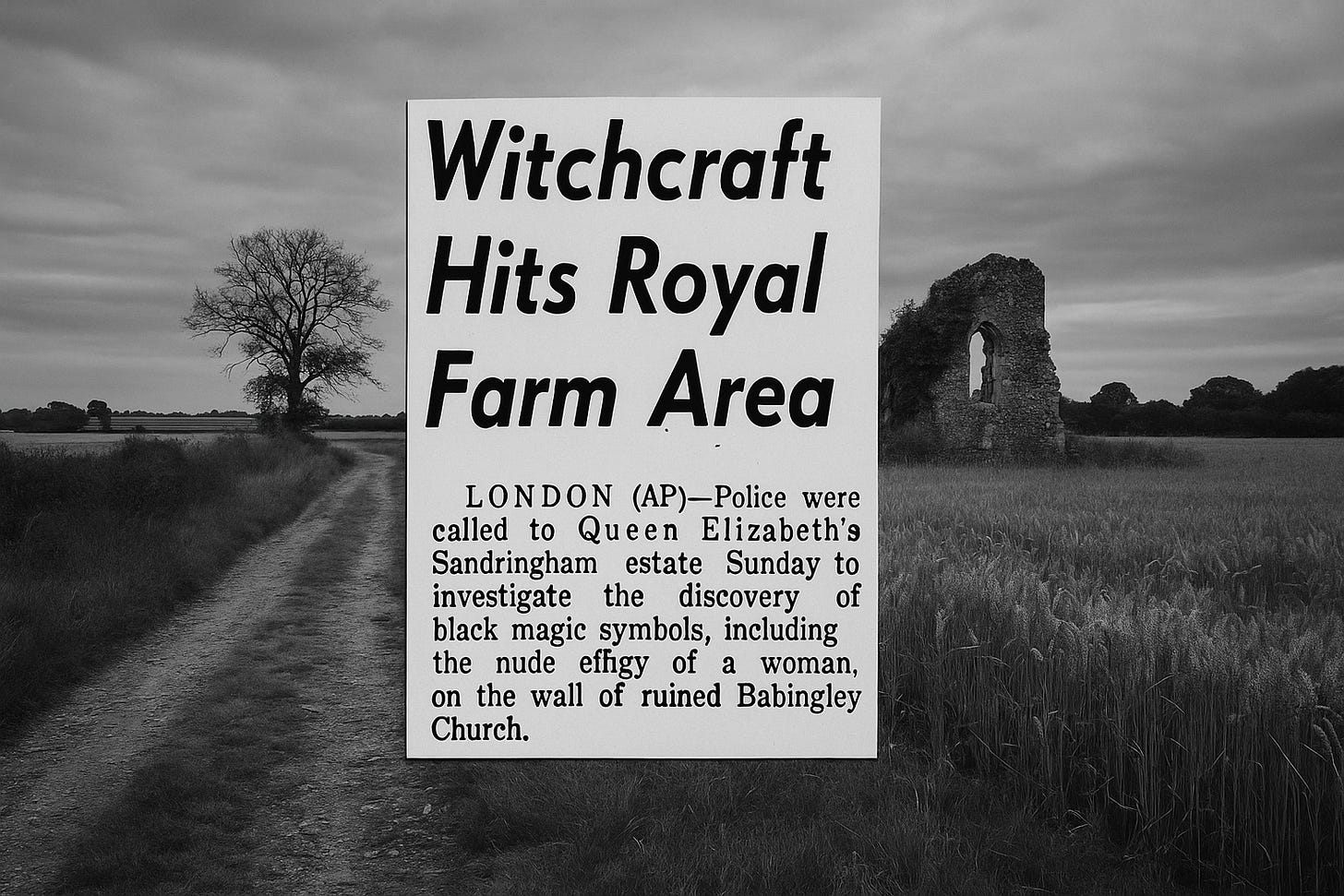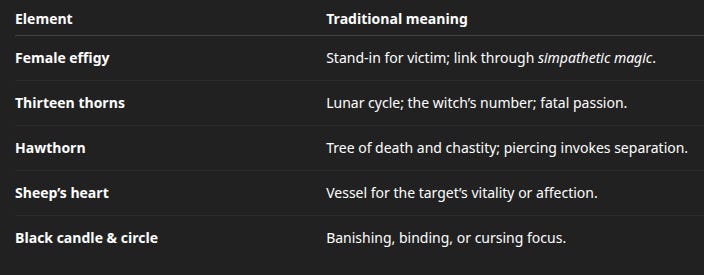🕯️ Witchcraft on the Queen’s Land?
A String of Macabre Effigies Found in Ruined Churches Could Have Been Part of an Elaborate “Death Curse” in Rural Norfolk in 1964.
In the winter of 1964, whispers of witchcraft drifted through the royal estate at Sandringham.
Police were called, newspapers descended, and a ten-year-old schoolboy became the accidental discoverer of what seemed like a ritual straight from the pages of a Dennis Wheatley novel.
Among the ivy-covered ruins of Babingley Church, a mile north of Castle Rising, the boy found a six-inch clay effigy of a naked woman, her chest pierced by thirteen hawthorn twigs.
At its feet lay a sheep’s heart and the stub of a black candle.
The effigy had been pressed into the damp stone of the chancel wall as though for display.
Within hours Norfolk police were on the scene. The find was reported up the chain of command, for Babingley stood on land belonging to the Queen’s Sandringham estate.
A self-styled “witchcraft expert” — believed to be author F. R. Buckley — examined the artefacts and pronounced them a “death charm.”
“A curse, probably directed at an older woman in an affair with a younger man,” he told the press.
“The thirteen thorns signify fatal passion. It could well have been made by a jealous girl.”
By Monday morning, headlines crackled across Fleet Street:
“Witchcraft Hits Royal Farm Area.”
And suddenly, sleepy north Norfolk was at the centre of a minor moral panic.
Earlier Discoveries
Reporters soon learned that Babingley was not an isolated case.
In the preceding months, similar charms had been found in two other ruined churches within a few miles.
At St James’ Church, Bawsey, two King’s Lynn schoolboys stumbled on a sheep’s heart pierced with hawthorn twigs, placed in the middle of a black circle drawn in soot, with a candle at its centre.
And just days before the Babingley effigy surfaced, an eleven-year-old exploring the same ruin had discovered a wax figure impaled with a thorn, laid above another sheep’s heart.
Each site lay along the same rural ridge: the lost medieval parishes of Babingley, Bawsey, and Castle Rising — all within the wider Sandringham estate, all long associated with ghost stories and the restless dead.
The Ritual Logic
To modern eyes it looked like Gothic vandalism.
But to anyone versed in East Anglian folk-magic, the symbolism was precise:
Put together, it was a textbook blighting spell — an act to end love, cause illness, or drive a rival away.
Not Satanic in any grand sense; more likely personal passion turned ritual.
Norfolk: Land of Faith and Fear
The affair unfolded against a landscape already steeped in superstition.
From the Witch of Wells-next-the-Sea to the Black Shuck of the coastal lanes, Norfolk has long blurred the boundary between the sacred and the strange.
Even the royal estate isn’t immune. Just a few miles south, at Castle Rising, stands the Hospital of the Holy and Undivided Trinity — an almshouse for thirteen widows whose ceremonial cloaks and pointed hats once made them look uncannily like a witches’ coven.
(See my earlier piece: The Thirteen Bedes of Sandringham: England’s Accidental Coven)
So when police found effigies and animal hearts in the ruins, it felt less like an isolated prank and more like the old current rising again — the ancient East Anglian habit of mixing prayer with spellcraft.
Media Panic and Aftermath
For a week or two, the nation’s papers dined out on the mystery.
There were rumours of “ritual orgies,” secret cults, even whispers that the Queen herself had been the intended victim — though no evidence supported that.
In truth, the case quietly faded. The police filed their reports; the artefacts were destroyed. No culprit was ever found.
But the image endured: black candles burning in ruined chancels, thorns driven into clay hearts, and the sense that something half-forgotten still stirs beneath the flat fields of Norfolk.
The Real Magic
Whether the rites were the work of a jealous lover, an amateur magician, or a prankster with an old folklore manual, they show how tenacious England’s hidden traditions remain.
Even under the bright modern reign of Elizabeth II, someone on royal soil was still whispering to older powers — the kind that answer only in silence, smoke, and thorn.
👁️ Watch the Original BBC Newsreel
The BBC’s own report on the 1964 Sandringham witchcraft investigation survives in the archives — a black-and-white time capsule of Britain’s uneasy dance between superstition and modernity.
👉 Watch the footage here on YouTube
🔮 Related Reading
If this tale of rural sorcery on royal soil intrigues you, step further back in time to The Thirteen Bedes of Sandringham: England’s Accidental Coven — the story of the black-cloaked widows whose appearance, centuries earlier, looked uncannily like the archetypal witches of English legend.
→ Read it here



